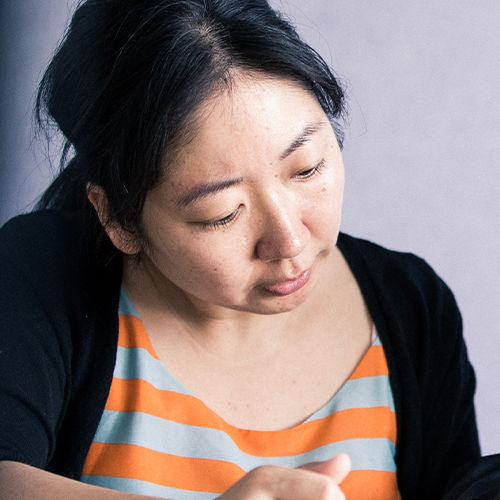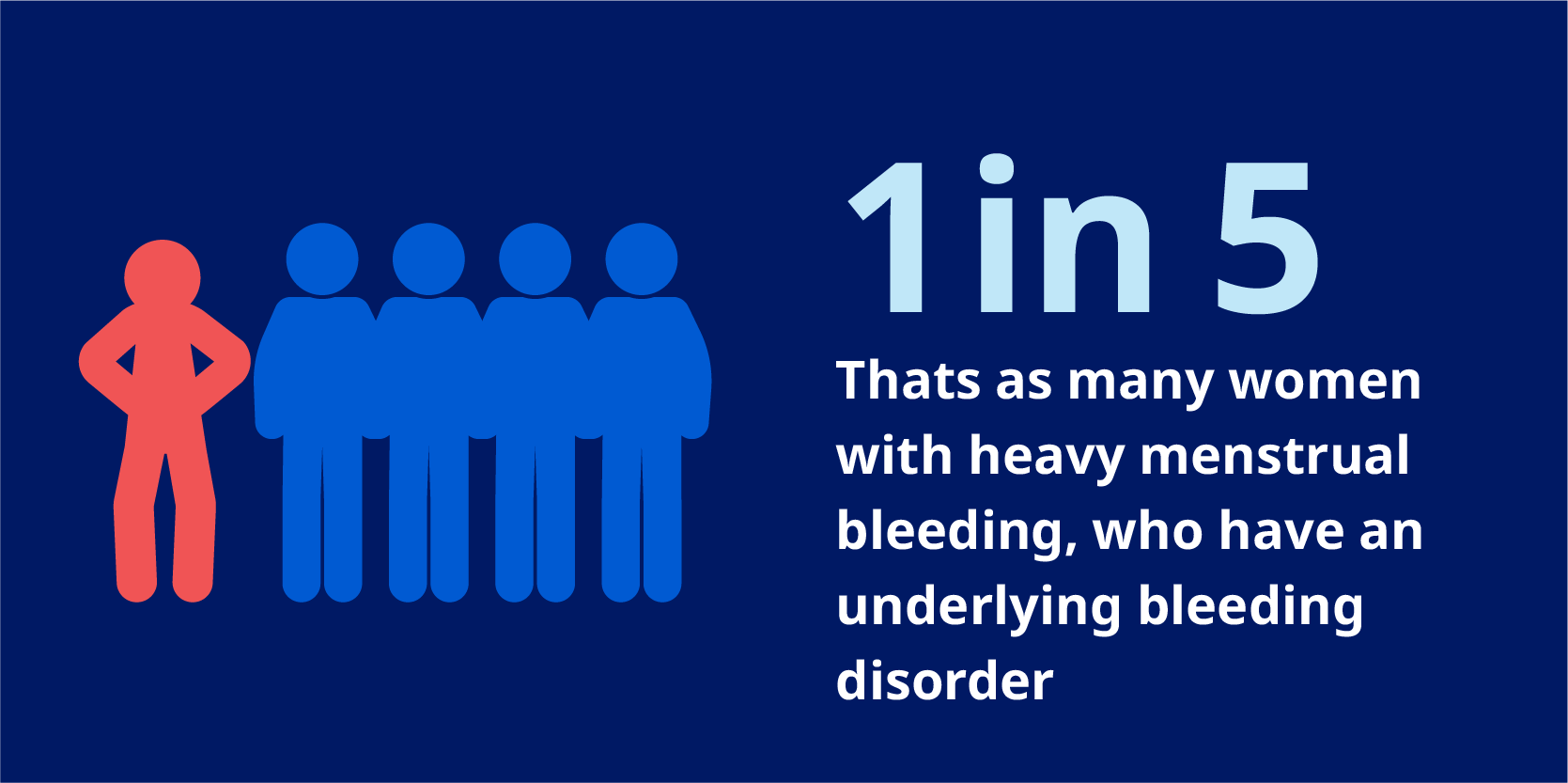
Talking to your healthcare team
Visiting your healthcare team can be daunting and you may feel overwhelmed. With that in mind, we have developed this short discussion guide.
Heavy menstrual bleeding affects millions of women around the world. 1 2 3 While it can occur on its own, heavy menstrual bleeding is also one of the most common bleeding symptoms in women with bleeding disorders. 12 As many as one in five women with a heavy period have an underlying bleeding disorder. 4 5 6 7 8 9 10 11 At the same time, estimates show that up to 90% of women with an underlying bleeding disorder experience a heavy period. 13 14 15 16 17
Because heavy menstrual bleeding can have a significant impact on health and quality of life, it is important to raise awareness for heavy menstrual bleeding and bleeding disorders to ensure that women and girls are properly diagnosed and get the support they need.
Even though heavy menstrual bleeding and bleeding disorders and stigma are common, it is not always apparent due to issues with diagnosing. Women and girls who have a heavy period and/or could have bleeding disorders are often diagnosed late or not at all. There is a median delay of 8-16 years without a proper diagnosis.4 18 19 20 21 22 During this time, there are many missed opportunities to make lives better for those that are affected by heavy menstrual bleeding or bleeding disorders.
One contributing factor could be the fact that women and girls may not recognize their symptoms are abnormal because they compare their experiences with women in their own families who may also suffer from heavy menstrual bleeding. 28 Families, especially mothers, are very important sources of information for menstruation. 74% of women surveyed said they received advice and learned about menstruation from their mothers. 28 The fact that heavy menstrual bleeding is often normalized in families makes it all the more important to provide adolescents with information about what is and what is not normal in menstruation. 28
In addition to normalization of symptoms, another factor that may contribute to the delay of diagnosing heavy menstrual bleeding is the stigma associated with menstruation. Although there are differences across countries, there are still high levels of stigma around having or discussing periods. Research shows that girls and women may feel embarrassed by their periods and the symptoms of heavy menstrual bleeding and/or feel that periods are a socially unacceptable topic of discussion. 28 Some women may also find it more difficult to discuss menstruation with men, including male obstetrics and gynecology physicians (OBGYNs) and nurses. 28
Based on surveys with general practitioners and OBGYNs, it’s been found that social stigma had at least some negative impact on the likelihood of women seeking treatment for heavy menstrual bleeding. 28
For this reason, it is important to enable patients to talk about their menstruation with their physicians, as well as for physicians to ask patients about their menstruation. There’s a need to raise awareness for heavy menstrual bleeding and bleeding disorders to ensure that women and girls are correctly diagnosed and get the support they need.
Heavy menstrual bleeding (on its own and as part of an underlying bleeding disorder) can have a significant impact on the physical and mental health and quality of life of women and girls.23 24 The effects of a heavy period can range from disruptions to social activities, education, and work-life, to fatigue from iron deficiency. 2 25 26
Research commissioned by Novo Nordisk Rare Disease found that 34% of menstruating women said they always or often have disruptions to their daily lives during the heaviest days of their period. For those women who report at-risk symptoms of heavy menstrual bleeding, the percentage who have frequent disruptions increases to 61%. 28
In a separate survey of university students, 35% reported heavy menstruation. Of those respondents, 60% felt their quality of life was significantly affected, nearly half reported that a university exam was affected, and over half said they missed a social event every month because of heavy menstruation. 25 In another study of 849 women with heavy menstrual bleeding, nearly 60% felt their heavy period more or less severely impaired their work. 30
“They're missing school, they're missing out on the social aspect of life. Maybe they don't swim, maybe there are activities they don't participate in. It truly breaks my heart to think that this is something that we can actually do something about, that's impairing social growth and activity, and so on, in young women.”
Dr. Natasha Pardy, Haematologist, Memorial University of Newfoundland, Canada, in an interview as part of the research
There are too many cases of heavy menstrual bleeding and bleeding disorders going undiagnosed, and too many women and girls without access to the care they need. In recent years, the bleeding disorder community has made very important progress on this issue. Now is the time to raise the health agenda around the world.
To learn more about heavy menstrual bleeding and its effects on women and girls, check out the report below.
1. Centers for Disease Control and Prevention, Bleeding Disorders in Women, Heavy Menstrual Bleeding. https://www.cdc.gov/ncbddd/blooddisorders/women/menorrhagia.html [Last accessed 14 December 2021].
2. Kadir RA, Edlund M, Von Mackensen S. The impact of menstrual disorders on quality of life in women with inherited bleeding disorders. Haemophilia. 2010;16(5):832-839. doi:10.1111/j.1365-2516.2010.02269.x
3. Liu Z, Doan QV, Blumenthal P, Dubois RW. A systematic review evaluating health-related quality of life, work impairment, and health-care costs and utilization in abnormal uterine bleeding. Value Health. 2007;10(3):183-194. doi:10.1111/j.1524-4733.2007.00168.x
4. van Galen K, Lavin M, Skouw-Rasmussen N, et al. European principles of care for women and girls with inherited bleeding disorders. Haemophilia. 2021;27(5):837-847. doi:10.1111/hae.14379
5. Kadir RA, Economides DL, Sabin CA, Owens D, Lee CA. Frequency of inherited bleeding disorders in women with menorrhagia. Lancet. 1998;351(9101):485-489. doi:10.1016/S0140-6736(97)08248-2
6. Knol HM, Mulder AB, Bogchelman DH, Kluin-Nelemans HC, van der Zee AG, Meijer K. The prevalence of underlying bleeding disorders in patients with heavy menstrual bleeding with and without gynecologic abnormalities. Am J Obstet Gynecol. 2013;209(3):202.e1-202.e2027. doi:10.1016/j.ajog.2013.05.059
7. Davies J, Kadir RA. Heavy menstrual bleeding: An update on management. Thromb Res. 2017;151 Suppl 1:S70-S77. doi: 10.1016/S0049-3848(17)30072-5
8. Edlund M, Blombäck M, von Schoultz B, Andersson O. On the value of menorrhagia as a predictor for coagulation disorders. Am J Hematol. 1996;53(4):234-238. doi:10.1002/(SICI)1096-8652(199612)53:4<234::AID-AJH4>3.0.CO;2-Z
9. Dilley A, Drews C, Miller C, et al. von Willebrand disease and other inherited bleeding disorders in women with diagnosed menorrhagia. Obstet Gynecol. 2001;97(4):630-636. doi:10.1016/s0029-7844(00)01224-2
10. Goodman-Gruen D, Hollenbach K. The Prevalence of von Willebrand disease in women with abnormal uterine bleeding. J Womens Health Gend Based Med. 2001;10(7):677-680. doi:10.1089/15246090152563551
11. Philipp CS, Dilley A, Miller CH, et al. Platelet functional defects in women with unexplained menorrhagia. J Thromb Haemost. 2003;1(3):477-484. doi:10.1046/j.1538-7836.2003.00061.x
12. James AH. Women and bleeding disorders. Haemophilia. 2010;16 Suppl 5:160-167. doi:10.1111/j.1365-2516.2010.02315.x
13. James AH. Heavy menstrual bleeding: work-up and management. Hematology Am Soc Hematol Educ Program. 2016;2016(1):236-242. doi:10.1182/asheducation-2016.1.236
14. James AH, Kouides PA, Abdul-Kadir R, et al. Von Willebrand disease and other bleeding disorders in women: consensus on diagnosis and management from an international expert panel. Am J Obstet Gynecol. 2009;201(1):12.e1-12.e128. doi:10.1016/j.ajog.2009.04.024
15. Kadir RA, Economides DL, Sabin CA, Pollard D, Lee CA. Assessment of menstrual blood loss and gynaecological problems in patients with inherited bleeding disorders. Haemophilia. 1999;5(1):40-48. doi:10.1046/j.1365-2516.1999.00285.x
16. Kouides PA, Phatak PD, Burkart P, et al. Gynaecological and obstetrical morbidity in women with type I von Willebrand disease: results of a patient survey. Haemophilia. 2000;6(6):643-648. doi:10.1046/j.1365-2516.2000.00447.x
17. Ragni MV, Bontempo FA, Hassett AC. von Willebrand disease and bleeding in women. Haemophilia. 1999;5(5):313-317. doi:10.1046/j.1365-2516.1999.00342.x
18. Weyand AC, James PD. Sexism in the management of bleeding disorders. Res Pract Thromb Haemost. 2020;5(1):51-54. Published 2020 Dec 13. doi:10.1002/rth2.12468
19. Centers for Disease Control and Prevention. Data and Statistics on von Willebrand Disease. https://www.cdc.gov/ncbddd/vwd/data.html [Last accessed 08 December 2021].
20. Jacobson AE, Vesely SK, Koch T, Campbell J, O'Brien SH. Patterns of von Willebrand Disease Screening in Girls and Adolescents With Heavy Menstrual Bleeding. Obstet Gynecol. 2018;131(6):1121-1129. doi:10.1097/AOG.0000000000002620
21. Atiq F, Saes JL, Punt MC, et al. Major differences in clinical presentation, diagnosis and management of men and women with autosomal inherited bleeding disorders. EClinicalMedicine. 2021;32:100726. Published 2021 Jan 29. doi:10.1016/j.eclinm.2021.100726
22. Srivaths LV, Zhang QC, Byams VR, et al. Differences in bleeding phenotype and provider interventions in postmenarchal adolescents when compared to adult women with bleeding disorders and heavy menstrual bleeding. Haemophilia. 2018;24(1):63-69. doi:10.1111/hae.13330
23. Shankar M, Chi C, Kadir RA. Review of quality of life: menorrhagia in women with or without inherited bleeding disorders. Haemophilia. 2008;14(1):15-20. doi:10.1111/j.1365-2516.2007.01586.x
24. Winkler UH. The effect of tranexamic acid on the quality of life of women with heavy menstrual bleeding. Eur J Obstet Gynecol Reprod Biol. 2001;99(2):238-243. doi:10.1016/s0301-2115(01)00414-6
25. Anastasakis E, Kingman CE, Lee CA, Economides DL, Kadir RA. Menstrual problems in university students: an electronic mail survey. In Vivo. 2008;22(5):617-620.
26. Winkler UH. The effect of tranexamic acid on the quality of life of women with heavy menstrual bleeding. Eur J Obstet Gynecol Reprod Biol. 2001;99(2):238-243. doi:10.1016/s0301-2115(01)00414-6
27. Anastasakis E, Kingman CE, Lee CA, Economides DL, Kadir RA. Menstrual problems in university students: an electronic mail survey. In Vivo. 2008;22(5):617-620.
28. Tarawah A, Shridhar N, Kulkarni R. Driving change to improve diagnosis of heavy menstrual bleeding and bleeding disorders in women and girls among healthcare providers. 2022.
HQ23CH00004


